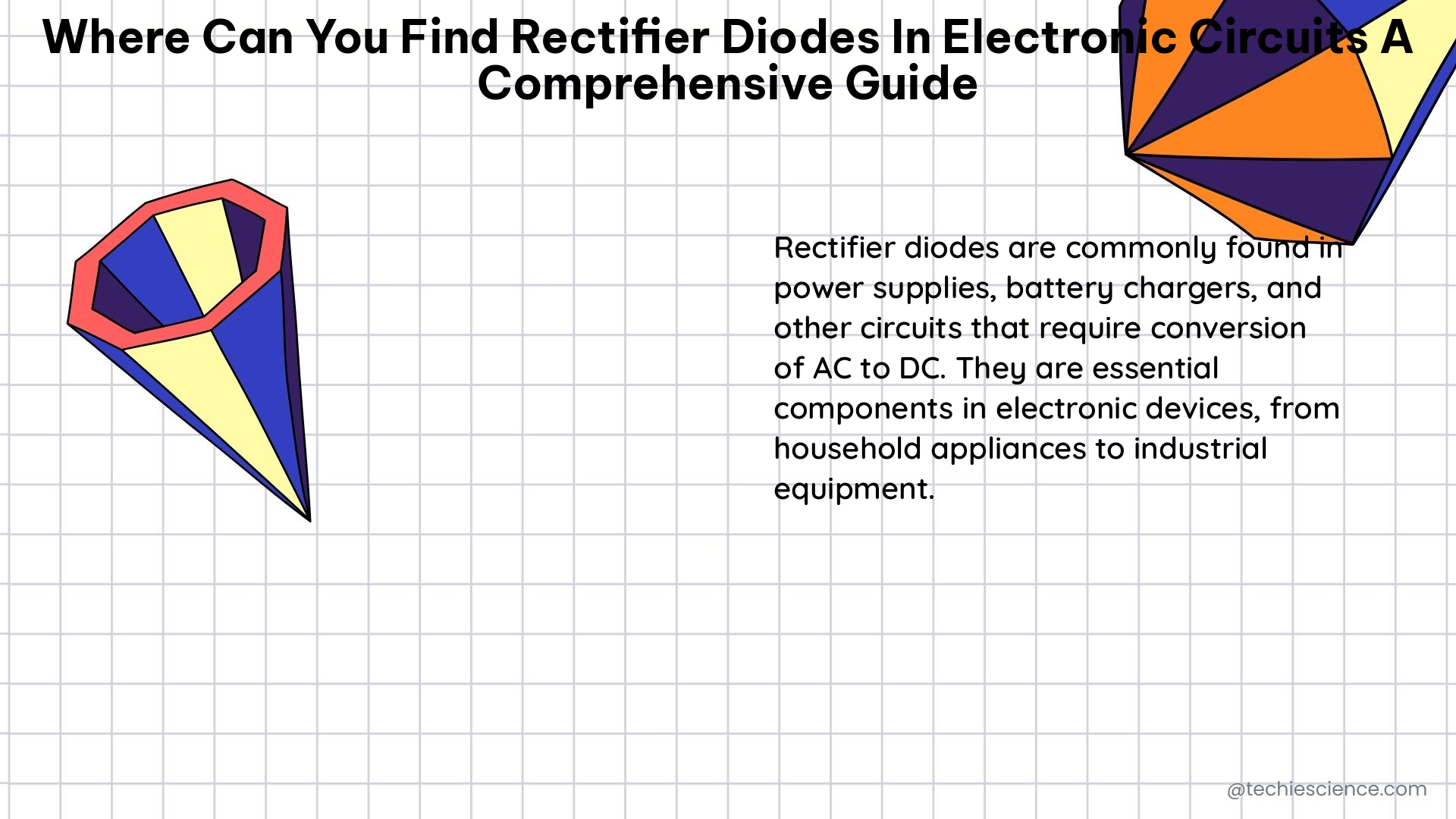Rectifier diodes are a crucial component in electronic circuits, responsible for converting alternating current (AC) to direct current (DC). They are commonly found in power supplies, signal processing circuits, and various other electronic systems. Understanding where to find rectifier diodes in electronic circuits requires a deep dive into their functions, applications, and the measurable data that defines their performance.
Types of Rectifier Diodes
Half-wave Rectifier
A half-wave rectifier is the simplest form of rectifier, using a single diode to allow only one half-cycle of the AC voltage waveform to be applied to the load. This results in a non-alternating waveform, where the negative half-cycles are blocked, and the positive half-cycles are passed through. The average DC voltage output of a half-wave rectifier is given by the formula: Vdc = 0.318Vmax, where Vmax is the peak input voltage.
Full-wave Rectifier
A full-wave rectifier, on the other hand, converts both halves of each waveform cycle into a pulsating DC signal using four rectification diodes. Full-wave rectifiers have two main types: center-tapped rectifier and bridge rectifier.
Center-tapped Rectifier
The center-tapped rectifier uses a transformer with a center-tapped secondary winding. Two diodes are connected to the load, and the load is connected at the center of the secondary of the transformer. The center tap is connected to the ground or common terminal. The average DC voltage output of a center-tapped full-wave rectifier is given by the formula: Vdc = 0.637Vmax, where Vmax is the peak input voltage.
Bridge Rectifier
The bridge rectifier uses four diodes arranged in a bridge configuration. During the positive half-cycle of the supply, diodes D1 and D2 conduct in series, while diodes D3 and D4 are reverse-biased. During the negative half-cycle, diodes D3 and D4 conduct in series, and diodes D1 and D2 switch off. The average DC voltage output of a bridge full-wave rectifier is also given by the formula: Vdc = 0.637Vmax, where Vmax is the peak input voltage.
Measurable and Quantifiable Data

-
Ripple Voltage: The ripple voltage is the fluctuation of the DC voltage from its average value. It is typically measured as a percentage of the average DC voltage. For a half-wave rectifier, the ripple factor is 1.21, while for a full-wave rectifier, the ripple factor is 0.482.
-
Output Frequency: The output frequency of a rectifier is twice the input frequency. For example, if the input AC frequency is 50 Hz, the output frequency will be 100 Hz for a full-wave rectifier.
-
Diode Forward Voltage Drop: The voltage drop across a diode when it is conducting current is typically around 0.7V for silicon diodes and 0.3V for germanium diodes.
-
Diode Reverse Recovery Time: The time it takes for a diode to switch from conducting to blocking current is known as the reverse recovery time. This parameter is critical in high-frequency applications, as a longer reverse recovery time can lead to increased power dissipation and reduced efficiency.
-
Power Conversion Efficiency: The power conversion efficiency of a rectifier circuit is the ratio of the output DC power to the input AC power. For a half-wave rectifier, the efficiency is 40.6%, while for a full-wave rectifier, the efficiency is 81.2%.
-
Transformer Utilization Factor: In a center-tapped full-wave rectifier, the transformer utilization factor is 0.707, meaning that the transformer is only utilizing 70.7% of its capacity. In a bridge rectifier, the transformer utilization factor is 1.11, indicating that the transformer is being utilized more efficiently.
-
Diode Peak Inverse Voltage (PIV): The peak inverse voltage (PIV) is the maximum reverse voltage that a diode can withstand without breaking down. This parameter is crucial in selecting the appropriate diode for a rectifier circuit, as the PIV must be greater than the peak input voltage.
Applications of Rectifier Diodes
Rectifier diodes are found in a wide range of electronic circuits and applications, including:
-
Power Supplies: Rectifier diodes are the backbone of power supply circuits, converting AC mains voltage to the required DC voltage for electronic devices.
-
Battery Chargers: Rectifier diodes are used in battery chargers to convert AC to DC for charging batteries.
-
Signal Processing Circuits: Rectifier diodes are used in signal processing circuits, such as demodulators and detectors, to extract the desired signal from a modulated carrier.
-
Motor Control: Rectifier diodes are used in motor control circuits, such as those found in variable-speed drives, to convert AC to DC for motor operation.
-
Lighting Control: Rectifier diodes are used in lighting control circuits, such as those found in dimmers, to control the brightness of lights.
-
Instrumentation and Measurement: Rectifier diodes are used in various instrumentation and measurement circuits, such as voltmeters and ammeters, to convert AC signals to DC for accurate measurement.
-
Telecommunications: Rectifier diodes are used in telecommunications equipment, such as modems and routers, to convert AC power to the required DC voltages.
By understanding the types of rectifier diodes, their measurable and quantifiable data, and their wide range of applications, electronics engineers and technicians can effectively design, troubleshoot, and maintain a variety of electronic circuits and systems that rely on the conversion of AC to DC.
Reference:
- Diode Rectifier Circuits – Electronics Notes
- Diodes and Rectifiers | Electronics Textbook – All About Circuits
- Diode Rectifier Circuits – Quarktwin Electronic Parts
- Rectifier Diode : Circuit Working, Testing & Its Applications – ElProCus
- Full Wave Rectifier and Bridge Rectifier Theory – Electronics Tutorials

The lambdageeks.com Core SME Team is a group of experienced subject matter experts from diverse scientific and technical fields including Physics, Chemistry, Technology,Electronics & Electrical Engineering, Automotive, Mechanical Engineering. Our team collaborates to create high-quality, well-researched articles on a wide range of science and technology topics for the lambdageeks.com website.
All Our Senior SME are having more than 7 Years of experience in the respective fields . They are either Working Industry Professionals or assocaited With different Universities. Refer Our Authors Page to get to know About our Core SMEs.